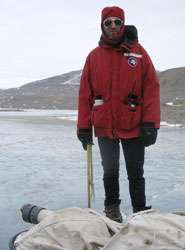Final frontier: Mission to explore buried ancient Antarctic lake given green light

An international team of scientists led by the UK has been given the go-ahead to explore one of the planet's last great frontiers - an ancient lake hidden deep beneath Antarctica's ice sheet. Buried under 3 km of ice, the lake - the size of Lake Windermere (UK) - may have been isolated for hundreds of thousands of years and could contain unique forms of life. The team hopes the exploration will yield vital clues about life on Earth, climate change and future sea-level rise.
Following the success in early 2008 of an International Polar Year project to map the extent and depth of subglacial Lake Ellsworth, the Natural Environment Research Council (Nerc) is funding a consortium of multidisciplinary researchers from nine UK universities, the British Antarctic Survey and the National Oceanography Centre, Southampton.
During the next five years the researchers will acquire and develop the technologies needed for this ambitious project. During the 2012-2013 Antarctic winter season the research team will go 'deep field' into West Antarctica to sample water from the lake in the search for tiny life forms never before seen; and to extract sediment from the lake bed to find clues as to how the climate has changed over many millennia.
Consortium leader Professor Martin Siegert from the University of Edinburgh said:
"This is a benchmark in polar exploration - our team will be the first to explore this ancient lake. It is a dark, cold place that has been sealed from the outside world and it's likely to contain unique forms of life. We hope to discover more about how life can exist in extreme environments and how Antarctica has changed in the past - which might help us understand more about other places on earth."
In such an extreme environment, the mere presence of life in itself would be a major scientific discovery, but there are very strong reasons to expect that such microorganisms would possess special or unique adaptations to this unusual and potentially hostile habitat.
David Blake, who is Head of Technology and Engineering at the British Antarctic Survey and is involved in the project, said:
"This project is a great scientific challenge and the technology required to drill 3 km through the ice without contaminating the lake is equally ambitious. Over the next few years we will build a hot water drill and probe, and make preparations to transport a sophisticated operation deep into the interior of West Antarctica. We really are at the frontiers of scientific exploration."
The exploration of subglacial lakes is part of an international effort to understand key global issues such as life in extreme environments and climate change.
More information:
Lake Ellsworth is 3 km beneath the ice; long and thin and around 20 km2 in area. Results from 2008/2009 experiments revealed that the lake is 150 m deep.
Around 150 lakes have been discovered beneath Antarctica's vast ice sheet and so far little is known about them. Getting into the lake is a huge technological challenge but the effort is worth it. These lakes are important for a number of reasons. For example, because water acts as a lubricant to the ice above they may influence how the ice sheet flows. Their potential for unusual life forms could shed new light on evolution of life in harsh conditions; lake-floor sediments could yield vital clues to past climate. They can also help us understand the extraterrestrial environment of Europa (one of the moons of Jupiter).
Since the 1970s scientists have used radar, seismic and satellite technologies to discover over 150 lakes locked beneath Antarctica's vast ice sheets. The water beneath the ice remains liquid because of small levels of heat from the Earth's core coming up through bedrock and from the insulating effect of several kilometres of ice above. The largest and most well known of these is Lake Vostok on East Antarctica. The lake is thought to be roughly the size of Lake Ontario.
Some subglacial lakes may be as old as the ice sheet. The age of the water within the lakes will be as old as the ice which melts into them, which in West Antarctica is around 150,000 years.
Source: British Antarctic Survey




















